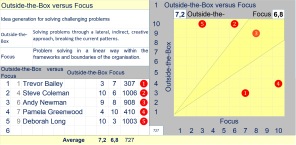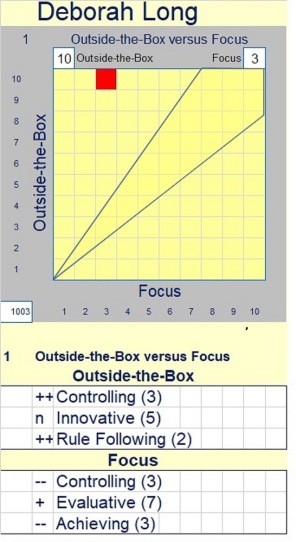THINKING STYLES
We all employ different ways of thinking — some of us take a creative approach, while others are more analytic; some are focused on the short-term, while others think about the long-term.
The American author Taylor Bennett recently did a study on thinking styles.
She recognises 5 different personality types:
· The Synthesist, who stands out with their creativity and curiosity; the Synthesist likes to
consider different ideas, views and possibilities.
· The Idealist, who always sets out and works toward big goals— the Idealist sets the bar high
and expects others to do the same.
· The Pragmatist, who takes a logical approach to problem-solving; the Pragmatist focuses on
immediate results, as opposed the long-term effects.
· The Analysts, who mainly is interested in the facts and data points — the Analyst has a
clear procedure for doing all things.
· The Realist, who is a perfect problem-solver; the analyst tackles problems head-on and
does not feel challenged by your everyday conundrum.
While we all have unique minds, we use to typify people. There is nothing wrong with that, unless we need to dig deeper into the interaction process of a team, into the different personalities involved, and into their specific thinking biases.
Actually, a person can apply quite a number of the above thinking styles (and even think in the opposite way), depending on what happens in a team.
Therefore LDpe had defined 7 thinking style paradoxes. Based on the individual's personality, we can even identify the participants' individual biases. By composing teams with a diversity in thinking styles, we can also influence the process in the team, such that paradoxical solution alternatives and their pros an cons will be identified and discussed thoroughly in the team.
But, let's first give some examples of Thinking style paradoxes:
Why do some people always seem to have new ideas while others of equal intelligence never do?
Lateral Thinking, as already in 1967 defined by Edward de Bono, still helps us in creative thinking and problem solving. De Bono argues that conventional vertical thinking often inhibits our ability to solve problems and come up with new ideas.
De Bono developed a number of techniques that can help us thinking laterally, for instance the six thinking hats technique.
Thinking outside the box, means to think differently, unconventionally, or from a new perspective.
This refers to novel or creative thinking. The term derives from management consultants in the 1970s and 1980s, challenging clients to solve the "nine dots" puzzle, whose solution requires some lateral thinking.
Divergent thinking is a thought process or method used to generate creative ideas by exploring many possible solutions. It typically occurs in a spontaneous, free-flowing, "non-linear" manner, such that many ideas are generated in an emergent cognitive fashion.
Many possible solutions are explored in a short amount of time, and unexpected connections are drawn.
Following divergent thinking, ideas and information are organized and structured using convergent thinking, which follows a particular set of logical steps to arrive at one solution, which in some cases is a "correct" solution.
Convergent thinking is a term coined by Joy Paul Guilford. It generally means the ability to give the "correct" answer to standard questions that do not require significant creativity, for instance in most tasks in school and on standardized multiple-choice tests for intelligence.
As you could see in the video, both divergent thinking and convergent thinking, both extremes in a paradoxical relation, are needed during the innovation process.
A paradox, (Wikipedia) also known as an antinomy, is a logically self-contradictory statement or a statement that runs contrary to one's expectation. It is a statement that, despite apparently valid reasoning from true premises, leads to a seemingly self-contradictory or a logically unacceptable conclusion. A paradox usually involves contradictory-yet-interrelated elements, that exist simultaneously and persist over time.
For an optimal innovation process, it is important that both extremes of thinking styles are involved, but it is certainly not plausible that these extremes are represented in the mind of one single person. This is why it is wise to combine the different ways of thinking in the combination of personalities in a team.
Diversity in Personality Traits
Every person will be, based on his/her personality, be biased, when considering solutions for a challenging problem; different personalities tend to arrive at different solution alternatives.
Only teams that are able to conduct a thorough dialogue on the pro's and con's of the extremes of a paradox (or a complex problem) will be qualified to find the innovative solution alternatives.
Designing teams including participants with opposite biases will enlarge the possibilities to find creative synthesised solutions.
Example Team Design
To the right you see the scores of a team on the thinking style paradox Ouside-the-Box versus Focus. The most extreme personalities in this scheme are Pamela Greenwood (high focus) and Deborah Long (high outside-the-box).
Andy Newman can do both types of thinking.
Click on the picture to see the details
Deborah Long is a good Outside-the-Box thinker.
Loooking at the cause of this, we see that her personality profile reflects this in the low scores on Controlling and Rule Following.
Deborah's score on Innovative is, like Pamela Greenwoods, also neutral.
Deborah's low score on Focus is caused by the same personality scores. And although her score on Evaluative has a little positive effect, her Focus score stays relatively low.
Funny to see that both ladies have a personality profile with a neutral score on Innovative.
And yet, on account of their
complementarity on the paradoxal axis of Outside-the-box thinking versus Focussed thinking, they both contribute largely in the team's innovation qualities.
LDpe's Advanced Team Design Tool will enable us to compose the right mixture of personalities and teamroles, and create optimal conditions for innovative solutions to emerge.
Thinking style paradoxes
After thorough analyses, we found a variety of thinking styles along six paradoxes:
- Outside-the-box versus Logical Thinking
- Associative versus Controlled Thinking
- Disruptive versus Compliant Thinking
- Divergent versus Convergent Thinking
- Focus on Headlines versus Details
- Intuitive versus Rational Decision Taking
- Prioritizing Values versus Norms
Now let's start to analyse the scores of Pamela Greenwood.
Have a look on the scheme to the left and the calculation table underneath.
The low score on Out-of-the-Box is caused by the fact that Pamela is a very Controlling personality.
In her personality profile she scores a very high score on Controlling, her low score on Rule-Following does not weigh up to this and her score on Innovative is neutral.
When we come to Pamela's high Focus score, we see that this score derives from her high score in the personality profile on both Controlling and Achieving and that even a high middle-score on Evaluative contributes here.
Next we will analyse the scores of Deborah Long.
With LDpe's Advanced Team Design Tool we can design complete innovative teams, based on the personality profiles of the different team members. While composing these teams we will both see to that the individual personalities will play complementary team roles (10 faces of Innovation) and that they also play complementary roles in regards to the different thinking style paradoxes.









